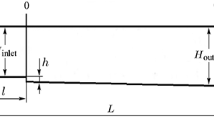Abstract
Results of an experimental study of hydrodynamics and diffusion combustion of hydrocarbon jets are presented. Various regimes of instability development both in the jet flame proper and inside the source of the fuel jet are considered. The experiments are performed for the case of subsonic gas jet expansion into the air from a long tube 3.2 mm in diameter in the range of Reynolds numbers from 200 to 13 500. The fuel is the propane–butane mixture in experiments with a cold jet (without combustion) and pure propane or propane mixed with an inert dilutant (CO2 or He) for the jet flame. The mean velocity and velocity fluctuations in the near field of the jet without combustion are measured. Among four possible regimes of cold jet expansion (dissipative, laminar, transitional, and turbulent), three last regimes are investigated. The Hilbert visualization of the reacting flow is performed. The temperature profiles in the near field of the jet are measured by a Pt/Pt–Rh thermocouple. An attached laminar flame is observed in the transitional regime of propane jet expansion from the tube. In the case of combustion of C3H8 mixtures with CO2 or with He in the range of Reynolds numbers from 1900 to 3500, the transitional regime is detected in the lifted flame. Turbulent spots formed in the tube in the transitional regime exert a significant effect on the flame front position: they can either initiate a transition to a turbulent flame or lead to its laminarization.
Similar content being viewed by others
References
G. J. Nathan, J. Mi, Z. T. Alwahabi, et al., “Impacts of a Jet’s Exit Flow Pattern on Mixing and Combustion Performance,” Prog. Energy Combust. Sci. 32, 496–538 (2006).
G. N. Abramovich, Theory of Turbulent Jets (Fizmatgiz, Moscow, 1960; MIT Press, Cambridge, 1963).
C. M. Ho and P. Huerre, “Perturbed Free Shear Layers,” Annu. Rev. Fluid Mech. 16, 365–424 (1984).
A. Michalke, “Survey on Jet Instability Theory,” Prog. Aerosp. Sci. 21 (3), 159–199 (1984).
Turbulent Mixing of Gas Jets, Ed. by G. N. Abramovich (Nauka, Moscow, 1974) [in Russian].
C. Gau, C. H. Shen, and Z. B. Wang, “Peculiar Phenomenon of Micro-Free-Jet,” Phys. Fluids 21 (9), 092001-1–092001-13 (2009).
Yu. A. Litvinenko, G. R. Grek, V. V. Kozlov, and G. V. Kozlov, “Subsonic Round and Plane Macrojets and Microjets in a Transverse Acoustic Field,” Dokl. Akad. Nauk 436 (1), 47–53 (2011) [Dokl. Phys. 56 (1), 26–31 (2011)].
V. V. Lemanov, V. I. Terekhov, K. A. Sharov, and A. A. Shumeiko, “Experimental Study of Submerged Jets at Low Reynolds Numbers,” Pisma Zh. Tekh. Fiz. 39 (9), 34–40 (2013) [Tech. Phys. Lett. 39 (5), 421–423 (2013)].
M. S. Krivokorytov, V. V. Golub, and I. A. Moralev, “Development of Instabilities in Gas Microjets under an Acoustic Action,” Pisma Zh. Tekh. Fiz. 39 (18), 38–44 (2013) [Tech. Phys. Lett. 39 (9), 814–817 (2013)].
V. M. Aniskin, V. V. Lemanov, N. A. Maslov, et al., “Experimental Study of the Flow in Subsonic Three-Dimensional Air Mini-and Microjets,” Pisma Zh. Tekh. Fiz. 41 (1), 94–101 (2015) [Tech. Phys. Lett. 41 (1), 46–49 (2015)].
V. V. Lemanov, V. I. Terekhov, and K. A. Sharov, “Investigation of the Flow in Free and Impinging Air Micro-and Macrojets,” Springer Proc. Phys. 185, 29–35 (2016).
T. Mullin, “Transition to Turbulence in a Pipe: a Historical Perspective,” Annu. Rev. Fluid Mech. 42, 1–24 (2011).
P. S. Kolhe and A. K. Agrawal, “Role of Buoyancy on Instabilities and Structure of Transitional Gas Jet Diffusion Flames,” Flow Turb. Combust. 79, 343–360 (2007).
N. Peters, Turbulent Combustion (Cambridge Univ. Press, 2000).
T. Takeno and Y. Kotani, “Transition and Structure of Turbulent Jet Diffusion Flames,” Prog. Astronaut. Aeronaut. 58, 19–35 (1978).
F. Takahashi, M. Mizomoto, and S. Ikai, “Transition from Laminar to Turbulent Free Jet Diffusion Flame,” Combust. Flame 48, 85–95 (1982).
B. J. Lee, J. S. Kim, and S. H. Chung, “Effect of Dilution on the Liftoff of Nonpremixed Jet Flames,” Proc. Combust. Inst. 25, 1175–1181 (1994).
A. M. Briones and S. K. Aggarwal, “A Numerical Investigation of Flame Liftoff, Stabilization, and Blowout,” Phys. Fluids 18 (4), 043603-1–043603-13 (2006).
V. S. Kozulin, V. L. Krainev, P. K. Tretyakov, and A. V. Tupikin, “Specific Features of the Diffusion Flame in the Transition from the Laminar to Turbulent Regime of Combustion,” Fiz. Goreniya Vzryva 50 (6), 134–136 (2014) [Combust., Explos., Shock Waves 50 (6), 742–744 (2014)].
R. C. Reid, J. M. Prausnitz, and T. K. Sherwood, The Properties of Gases and Liquids (MsGraw-Hill, 1977).
A. Banerjee and M. J. Andrews, “A Convection Heat Transfer Correlation for a Binary Air–Helium Mixture at Low Reynolds Number,” J. Heat Transfer 129 (11), 1494–1505 (2007).
Yu. N. Dubnishchev, V. A. Arbuzov, E. V. Arbuzov, et al., “Visualization of Convective Structures by Methods of the Hilbert Optics and Phase-Shift Interferometry,” in Proc. 10th Pacific Symp. on Flow Visualization and Image Processing, Naples, 2015, Paper ID:105.
V. A. Arbuzovet al., “Optical Diagnostics of Vortex Ring–Flame Interaction,” Avtometriya 52 (2), 66–72 (2016) [Optoelectron., Instrum., Data Proc. 52 (2), 161–166 (2016)].
R. Viskanta, “Heat-Transfer to Impinging Isothermal Gas and Flame Jets,” Exp. Therm. Fluid Sci. 6 (2), 111–134 (1993).
A. Hamins, J. C. Yang, and T. Kashiwagi, “An Experimental Investigation of the Pulsation Frequency of Flames,” Proc. Combust. Inst. 24, 1695–1702 (1992).
Author information
Authors and Affiliations
Corresponding author
Additional information
Original Russian Text © V.V. Lemanov, V.V. Lukashov, R. Kh. Abdrakhmanov, V.A. Arbuzov, Yu.N. Dubnishchev, K.A. Sharov.
Published in Fizika Goreniya i Vzryva, Vol. 54, No. 3, pp. 3–12, May–June, 2018.
Rights and permissions
About this article
Cite this article
Lemanov, V.V., Lukashov, V.V., Abdrakhmanov, R.K. et al. Regimes of Unstable Expansion and Diffusion Combustion of a Hydrocarbon Fuel Jet. Combust Explos Shock Waves 54, 255–263 (2018). https://doi.org/10.1134/S0010508218030012
Received:
Published:
Issue Date:
DOI: https://doi.org/10.1134/S0010508218030012




